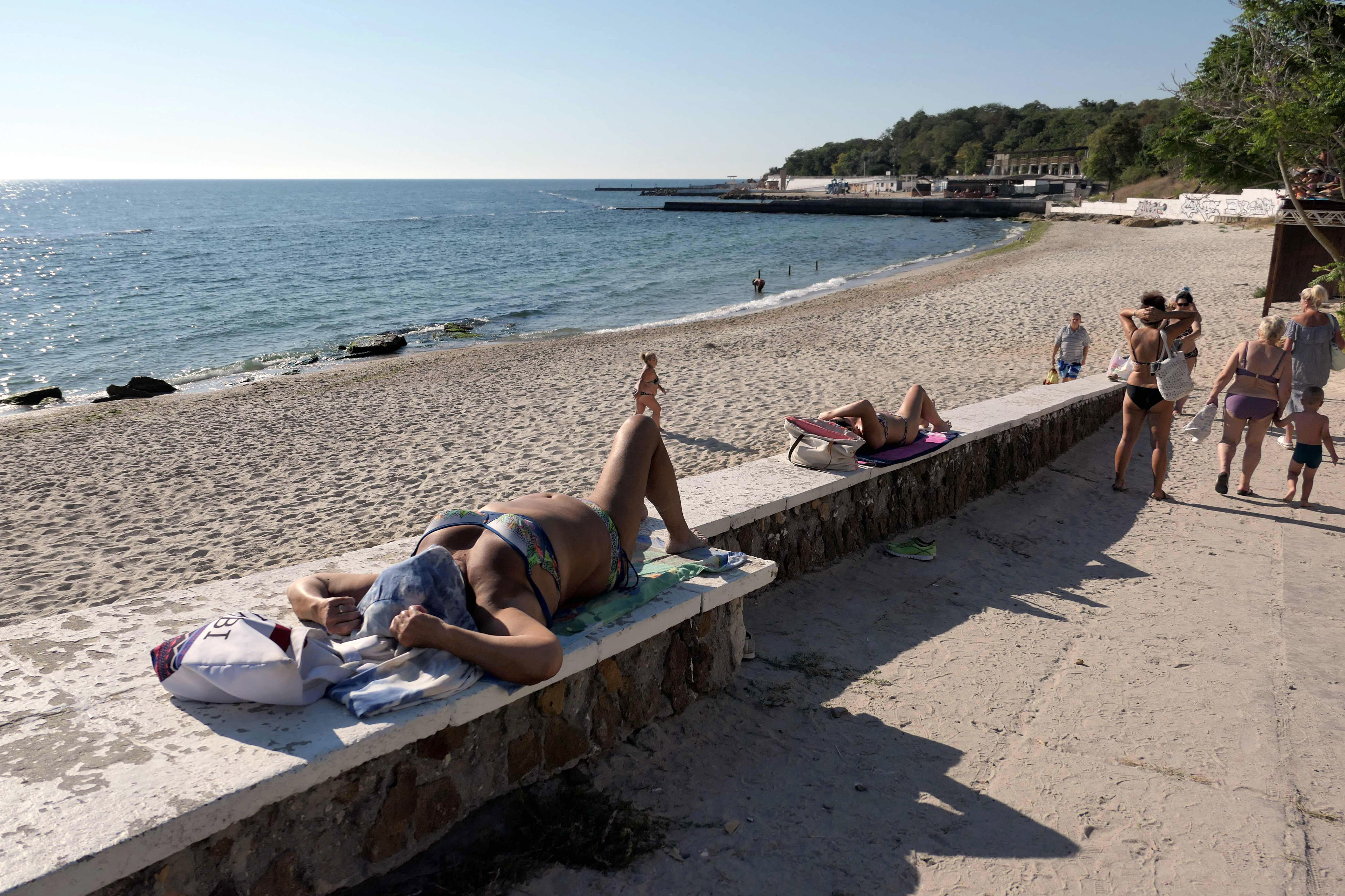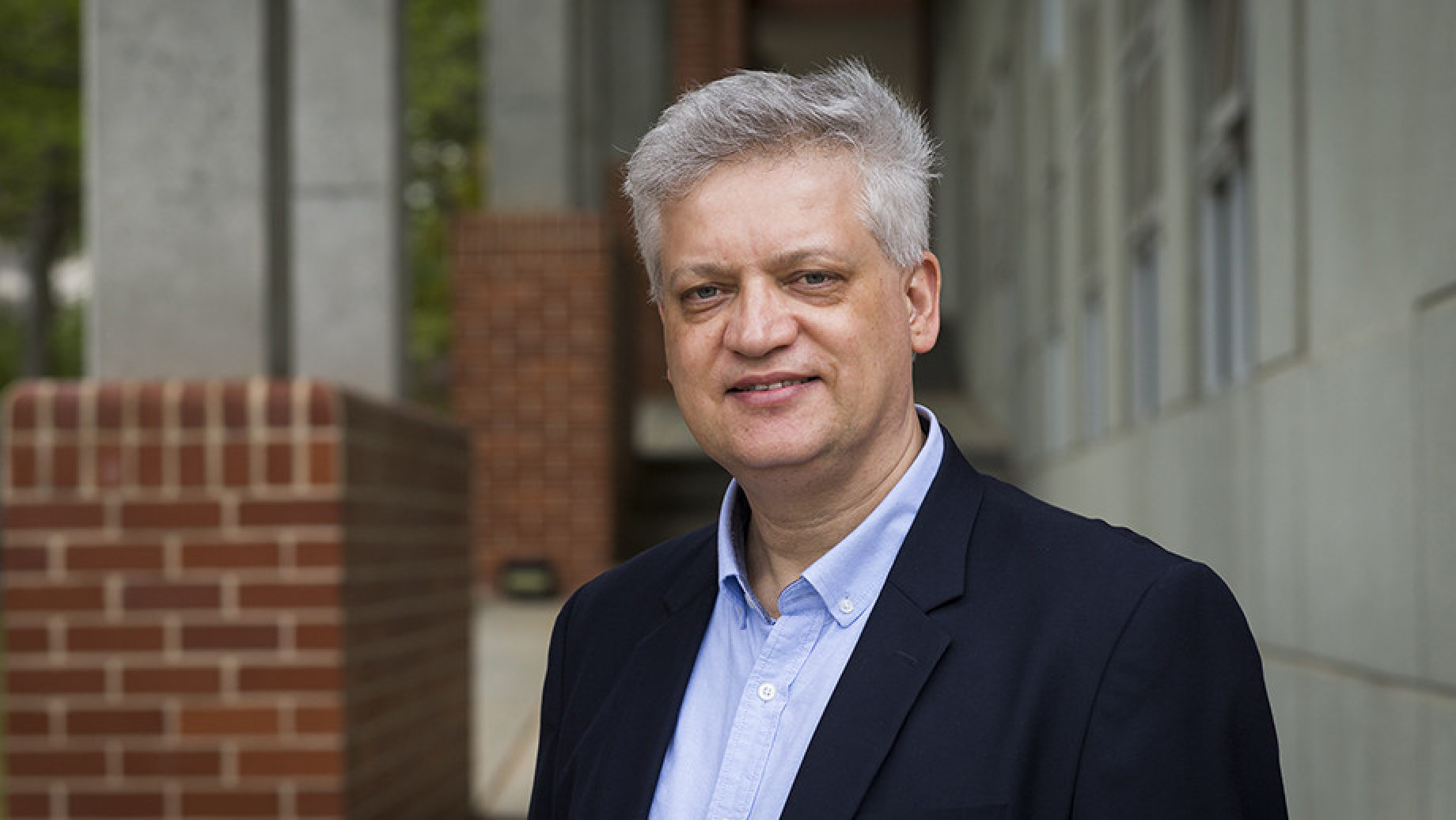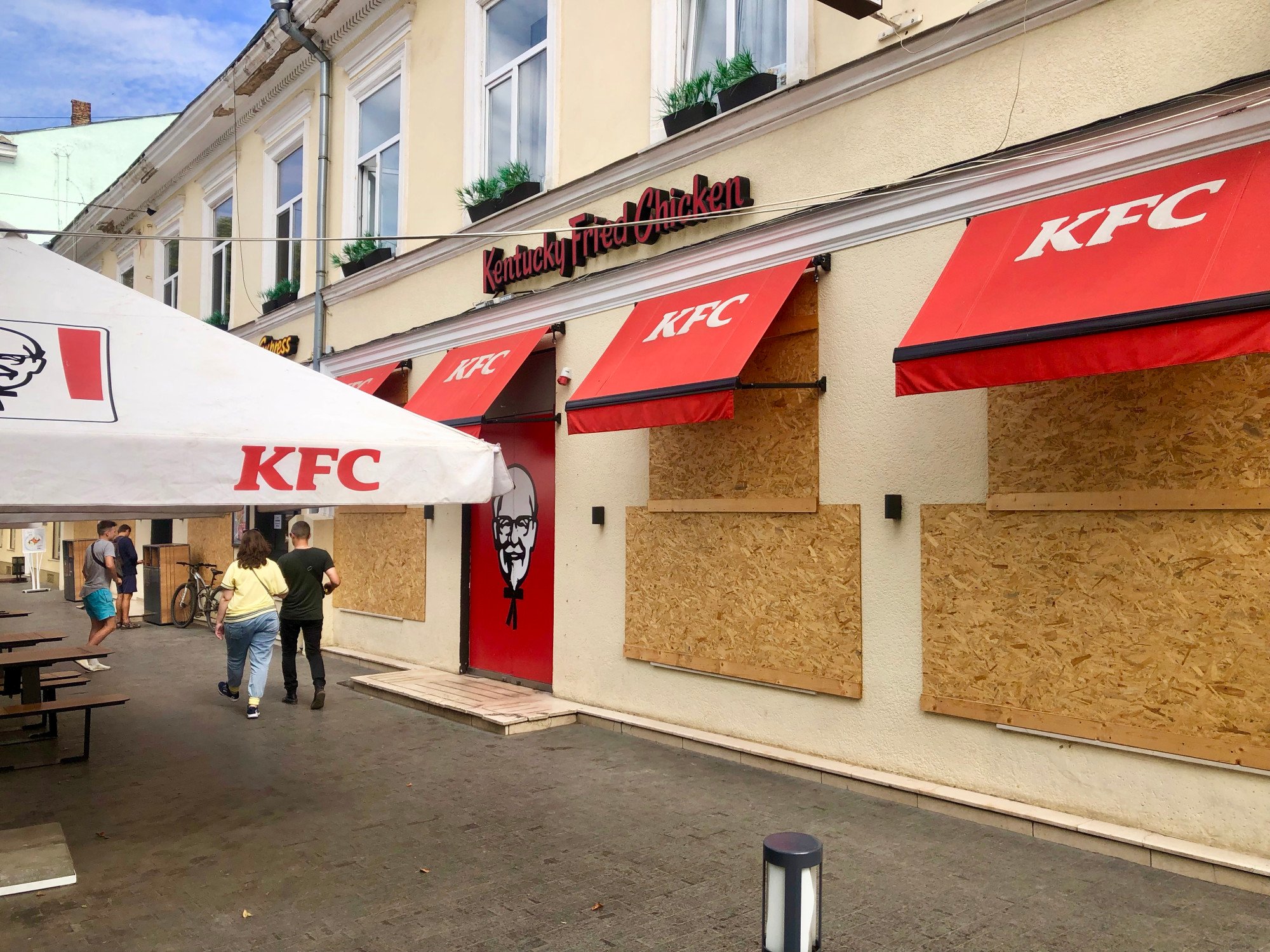
- Six months into the Russia-Ukraine war and with no end in sight, Post Magazine visits Mykolayiv and Odesa to see how people are living in Ukraine’s combat zones
Two old women sit on a bench in front of their flats in a state of resignation, the ground beneath them littered with shards of glass, bits of wood and metal fragments. Every window in their brutalist Soviet-era building is either cracked or blown out. The front door hangs precipitously from its hinges, waiting to fall.
As bad as it is, the damage pales in comparison to that of a charred block of flats down the road, where a cruise missile scored a direct hit in February, soon after Russia invaded Ukraine.
The top centre of the building bears a giant, semicircular gap, as if it caught the back of the heel of a giant stomping through the neighbourhood. Metres-high piles of rubble block the main entranceway and garage doors on street level.
“I never imagined this could happen in my city. The government, all the politicians, they said it was impossible,” says one of the women, Claudia. “I’m 72 years old. My flat is ruined. There’s no compensation. When winter comes, I’ll have nowhere to sleep.”
Anna, her neighbour here in Mykolayiv, a port city near the Black Sea, says, “We have no security now.”
Anatoli, an old man hobbling past on a pair of crutches, chimes in: “The situation in Ukraine has changed the world.”

A month before the invasion, United States President Joe Biden had expressed similar sentiments when asked by reporters about the fallout of a potential Russian attack on Ukraine: “It would be the largest invasion since World War II. It would change the world.”
At the St Petersburg International Economic Forum in June, Russia’s President Vladimir Putin claimed that “when the US declared victory in the Cold War, Americans designated themselves the messengers of God on Earth, with interests that should be considered sacred and no obligations,” but now, he said, “new centres of power have since emerged, and it is a mistake to suggest that one can wait out the times of turbulent change and that things will return to normal.”
‘I was screaming for help’: the Cambodian brides trafficked into China
As increasingly sophisticated and longer-range Western weapons enter the battlefields, Russia’s “special military operation” in Ukraine threatens to not just change the post-Cold War order, but haemorrhage into a larger-scale conflict: another battle between democracy and dictatorship.
“The world is poised on the brink of World War III,” warns Dr Leonid Petrov, a visiting fellow at the Australian National University, who studies territorial disputes and post-Soviet Russia. “Everyone is watching very carefully as to which way the war in Ukraine will swing.”

A former hub of Soviet shipbuilding where most of Russia’s biggest warships were built during the communist period, Mykolayiv was almost overrun by Russian forces in March. But the city’s defenders pushed the invaders back to Kherson, a city 60km (37 miles) to the east.
After retaking dozens of villages and settlements from the Russians in July, Ukraine’s southern counteroffensive began with a bang in the second week of August, targeting a massive weapons dump and enemy supply lines in the Crimean Peninsula, which Russia annexed in 2014.
Mykolayiv has fast emerged as a symbol of Ukrainian resistance. Much of the city’s vital infrastructure, from bridges and power stations to the town hall, remains intact because most of the Russian missile and artillery strikes – 70 per cent, according to Ukraine’s defence ministry spokesman Oleksandr Motuzyanyk – were on non-military targets such as blocks of flats.


But the economic carnage is complete.
In Mykolayiv’s central business district, a McDonald’s that was feeding soldiers for free in the first few weeks of the war has closed. Weeds have taken over its playground and outdoor seating area. Men who have not enlisted in the army wander around aimlessly, begging for change.
On a street corner, a grim hoarding shows a Russian soldier standing upon scorched earth with a Z – the invaders’ de facto symbol – splashed across his chest. In his hands are looted goods. He has the face of a troll. Not far away, an old man playing the accordion sings an old Russian dirge from World War II, his voice tinged with grief.
“Even before the war, the economic situation here was not so good,” says Slava Pavlenko, a schoolteacher who spends his spare time working for Goncharenko, a Ukrainian charity that distributes food parcels to the needy. “But now it is much worse, so much worse, you cannot imagine how many people on Facebook are asking for jobs, even for small money, because many people are without food.”

A quarter of a million people – more than half of Mykolayiv’s peacetime population – have already fled while 80 per cent of those who have remained rely on handouts, according to The New York Times. On the day of my visit, Mykolayiv’s mayor, Oleksandr Senkevych, tells a local radio station that “everyone who wants to survive” should get out.
But Pavlenko can’t go. “I was thinking about leaving when the war started but I can’t because my mother is not healthy and I cannot take her,” he says.
Some 130km west of Mykolayiv is Odesa. Founded by Catherine the Great in 1794, this cosmopolitan port city with wide acacia-tree-lined boulevards and grand gothic- and baroque-style buildings is known as the “Marseilles of Ukraine” due to its position on the Black Sea.
Before the war, it was the chief conduit for Ukraine’s multibillion-dollar grain and oilseed harvest and a booming tourism hub. More than 3.3 million tourists visited in pre-pandemic 2019.
In that instant I know what it’s like trying to live under constant threat from Russia … Outside the air is thick with the smell of burning petrol. Every car alarm in the street is screeching
The coastline and waters around Odesa are now pockmarked with mines to prevent a Russian naval landing and the once busy port lies silent. The city is playing a pivotal role in the defence of Ukraine as the launching pad for the two R-360 Neptune missiles that sank Russia’s Black Sea flagship the Moskva on April 14 and continues to rain down missiles on Russian oil rigs.
Putin has made no secret of his desire to capture Odesa. But with the skies shielded by anti-aircraft systems, and Russian troops bogged down in Kherson, Odesa is considered a haven by most of its residents and the refugees who have found shelter there.
On sunny weekends, thousands flock to the city’s mine-covered beaches where danger signs warn people to steer clear of the sand and blue water. In June, a man who ignored the warnings was blown up in front of his wife and son. Most, however, just sunbathe on the boardwalk and sink beers and eat seafood at beachfront restaurants that would not look out of place on a Greek island or Spain’s Costa del Sol.
How one dog helped end the cruel sport of greyhound racing in Macau
The laid-back summer vibe flies in the face of everything I had seen on television about the war. I am walking around, taking it all in, when I hear an unfamiliar tone coming from my phone. It’s a notification from Air Alarm Ukraine, an app that uses my location to warn me of missile strikes. “Odesa Area – Air Alarm! Everyone to the Shelter!” it reads.
Moments later, sirens fill the air. My heart begins to race. Panic sets in. Yet, to my utter disbelief, no one on the boardwalk moves. Police officers continue walking their beats. Parents push their children on swings. I witness the same peculiar phenomenon over and over during my weeklong stay in Odesa. Air-raid sirens go off but no one runs for shelter. No one seems to care.
I find out why that was during a meeting with Peter Obukhov, a city councillor working to purge Russian names from streets and landmarks in Odesa. “The government owns some old bomb shelters from the second world war that are not in use. We want them to give us the keys so we can repair them and use them,” he says. “But for now, we have no bomb shelters.”

Obukhov also admits the city has no evacuation plan in the event of a Russian invasion and believes the estimated 20 to 30 per cent of residents who already fled did so as a result of stress caused by watching too much news on television.
“Of course Putin wants to take this city, he wants the whole of Ukraine,” says Obukhov. “But it’s nearly impossible from a military perspective so all he can do is shoot missiles at us and kill a few of us. Eleven have died so far. But how will that help him win the war? Even if he killed [Ukrainian President Volodymyr] Zelensky, it wouldn’t help his cause. He’d have to kill all of us.”
Sergiy Dibro, a columnist and military analyst for Ukrainian news site Dumskaya.net, has been writing about a potential Russian invasion of Ukraine since 2002.
“All my articles about Russia contained ideas about the inevitability of war because according to the Russian mindset, there can be no Russian empire without Ukraine. Only after Peter the Great conquered Ukraine in the 18th century did Russia become a pole of power in the world,” he says of the Russian tsar to whom Putin recently compared himself in a speech.
Irrespective, “it is impossible for Russia to take Odesa” now, he says, for the defences around the city are too well organised.
The West overestimated the death of totalitarianism. We thought it was dead and buried last century with the Nazis and Imperial JapaneseDr Leonid Petrov, a visiting fellow at the Australian National University
Over the next week, the sound of air-raid sirens echoes through Odesa with increasing frequency, up to 10 times a day.
At first, I take heed of every single warning, rush to the ground floor of my hotel and crouch in a hallway following the “two walls” survival theory, which suggests I am relatively safe here from the shrapnel and broken glass that has caused most of the civilian deaths and injuries in Russian missile strikes. But after a few days, I too become desensitised to the threat and stop reacting to missiles that never appear.
“We heard bombs every day. They never stopped,” says Leana Mezinkova, from the eastern Donetsk region, standing in a depot in Odesa giving away used clothing to fellow refugees. “At first it was very hard because I was nervous all the time and couldn’t sleep. My daughters wouldn’t stop crying. But then you get used to it. Humans can adapt to just about anything.”

On my last day in Odesa, I’m in my hotel room when the air-raid siren sounds again. I am on the phone talking to my mother and the noise makes it hard to hear her. I’m about to ask her to call me back when there’s a loud explosion. Its force is so terrible it sends a small shock wave through an open window. My ears ring for an hour.
In that instant I know what it’s like trying to live under constant threat from Russia. I rush down the stairwell. Outside the air is thick with the smell of burning petrol. Every car alarm in the street is screeching. I spend an hour walking through the city looking for the impact site but find nothing.
Later I learn the missile was shot down mid-air by Ukraine’s air defence systems. Fortress Odesa prevails once more.
“Today’s attack on the shopping mall in Kremenchuk is one of the most defiant terrorist attacks in European history,” Zelensky says in a public address, calling for the US State Department to designate the Russian Federation a state sponsor of terror. “Only terrorists who should have no place on Earth can strike missiles at such an object. Russia will stop at nothing.”

“After the collapse of the Soviet Union, we believed globalisation had prevailed and ‘the end of history’ was proclaimed. But the Cold War did not end decisively,” he says. “The West overestimated the death of totalitarianism. We thought it was dead and buried last century with the Nazis and Imperial Japanese.
“But now it has returned and the free world is in mortal danger. Putin is testing the West and all the military dictators are watching. They’re looking at the slaughter and carnage in Ukraine, the burning cities, to see which side prevails and plot their next move.”

Petrov, a Russian married to a Ukrainian, and experiencing fissures within his extended family over the conflict, says much depends on the determination of democratic powers.
“The West has one last chance to keep Ukraine in the orbit of its soft power. It’s great they’ve finally given the country EU membership though it’s probably too little too late,” he says. “Right now the West is not going far enough with military aid to Ukraine because they are afraid of Russia.
“If Russia wins, Putin will potentially decide to go further and invade Moldova, Lithuania or even Poland. Belarus is already mesmerised by his ideology, and fascism is now radiating to many of the former Soviet republics. Ukraine is the only rebel and that is the reason it was invaded.
“The war has also consolidated North Korea’s belief that the West should not be trusted, because if the previous Ukrainian government had kept their nuclear arsenal, Russia never would have invaded,” he says of the so-called Budapest Memorandum of 1994, when Ukraine handed 1,700 Soviet-era nuclear warheads to the Russians in exchange for security assurances from the US and Britain.
The Cold War race to deploy spy satellites may have prevented World War III
As I bump shoulders with dozens of Ukrainians trying to get a seat on a bus bound for Moldova, all of them echo Petrov’s warning. In a few hours, I will be safe from Russian missiles and my mother will be able to sleep again. But what of the mothers of those who missed the bus, staring listlessly as we pull out of the station?
The danger of letting Putin get his way in Ukraine is clear. He is already threatening two other neighbours: Finland, for applying to join Nato; and Lithuania, for blocking access to natural gas in the Russian enclave of Kaliningrad on the Baltic Sea.
“If [the West] helps Ukraine win and teaches Russia a lesson, dictators around the world will retreat,” says Petrov. “But if the Russians are allowed to win, it will be everyone against everyone.”

